Table of contents
Depending on when they are harvested, pumpkins ( Cucurbita ) are divided into winter and summer pumpkins . These include, for example, the Halloween pumpkin, the spaghetti squash, the patty pan squash, Rondini pumpkins (singular: Rondino), the oil pumpkin, the zucchini and the inedible ornamental pumpkins. However, this classification is not subject to any set standards, which can sometimes lead to confusion.
Use in the kitchen:
Summer squash can be used to make cream soups , stews, salads , casseroles, pies, cakes, pastries , compote, jam or juice. The flesh can also be frozen raw or pickled in a sweet and sour sauce. It is suitable for grilling or as a puree. Ginger, chili , curry , garlic, onion and vinegar go well with spicy squash dishes. Sweet dishes can be refined with honey , cinnamon , sweet wine or fruits such as pineapple , apples or oranges .
With young summer squash, you can use both the skin and the seeds, only the stem and the flower bud need to be removed. The flesh is a little firmer than that of a zucchini (a courgette), and the use is almost the same.
Pumpkins are generally suitable for eating raw. However, excessive amounts can cause stomach upset in sensitive people. Great caution is required with ornamental pumpkins, which should not be eaten raw or cooked! If pumpkins taste bitter, regardless of the type, raw or cooked, they should not be eaten.
Vegan recipe for patty pan pumpkin soup:
Ingredients : 1 kg patty pan, 2 carrots , 3 potatoes , 1 tbsp rapeseed oil , 1 onion , 600 ml water , salt ,pepper , nutmeg .
Preparation : Sauté the finely chopped onion in oil and put the finely chopped pumpkin (without seeds) in a pan together with the peeled and chopped carrots and potatoes. Small patty pan squash can be eaten with the skin on, but we recommend peeling larger ones or those with thick skin. Then add the water and cook the vegetables until soft. After pureeing with a hand blender, season with salt, pepper and nutmeg and serve.
Vegan recipe for stuffed Rondini pumpkins:
Ingredients : 2 pieces of Rondini, rapeseed oil, 1 onion, 2 cloves of garlic , 200 g smoked tofu , 1 red or yellow bell pepper , 2 tomatoes , 1/2 jar of olives (pitted), 1.5 tbsp soy sauce , 1 tsp raw sugar , vegetable stock (instant) , cayenne pepper , salt, thyme (dried) , paprika powder , 80 g vegan cheese .
Preparation : First, preheat the oven to 180°C and place the halved, hollowed-out Rondini in an oiled casserole dish in the oven for around 15 minutes. Remove the seeds and save the pulp. During this time, you can prepare the filling. Sauté the finely chopped onion together with the chopped or pressed garlic in oil until translucent. Sprinkle 1 teaspoon of sugar over the top, add the tofu cubes and fry. Deseed the peppers, chop them up and add them to the pan. Fry the halved olives and chopped tomatoes. Reduce the heat and season with the soy sauce and spices. Finally, stir in the vegan cheese. Take the empty Rondini out of the oven and fill them with the vegetables. Then put them back in the oven for around 20-25 minutes.
Rice and tomato sauce are excellent side dishes.
Vegan recipes with summer squash can be found under the note: " Recipes that have the most of this ingredient ".
| Not only vegans or vegetarians should read this: Vegans often eat unhealthily. Avoidable nutritional mistakes. |
Shopping - where to buy?
In the summer months, different types of summer squash can sometimes be found in supermarket chains such as Coop , Migros , Denner , Spar , Aldi , Lidl , Rewe , Edeka , Hofer etc. In any case, you can buy them during the season (in summer) at weekly markets, in organic shops, selected organic supermarkets or in regional shops (e.g. Volg ).
When buying a summer squash, make sure that the stem and skin are intact. A clear identifying feature of a summer squash is its sharp, angular stem, like the one found on zucchini.
Pumpkins should be grown organically if possible. They absorb certain pollutants, such as dieldrin (insecticide), from the soil.
Varieties commonly referred to as summer squash:
- The Halloween pumpkin is also aptly named Ghost Rider . It is particularly suitable for Halloween carvings, but is also edible. Its sweet, mild aroma tastes great in cakes or other fluffy desserts.
- The patty pan is also called a UFO pumpkin . Its shape is also reminiscent of a flower. The skin can be white, light green, striped or yellow-green. The taste is rather neutral; you can stuff the pumpkin or simply prepare the flesh and skin as a vegetable. Pickled patty pan tastes similar to gherkins.
- The Rondino ( plural: Rondini ) is a small, round pumpkin with a dark green skin and yellow flesh. The young fruits have a soft skin and taste similar to zucchini. If the pumpkin is fully ripe and has a hard skin, it can be stored until late winter. Due to their shape, Rondini can be easily stuffed or baked whole in the oven. This makes the vegetable very popular with children.
- The spaghetti squash is narrow and long, the skin is yellow to orange. The flesh contains long, spaghetti-like threads. After boiling in water or cooking in the oven, the threads can be easily removed with a spoon. The sweet, nutty spaghetti is ideal as a healthy pasta alternative.
- Some people also count the acorn squash as a summer squash. It has an acorn-like shape and is usually green with orange spots. There are also speckled or white varieties. The skin is ribbed and the flesh is firm and orange-yellow. The taste is reminiscent of pepper and hazelnuts. As an oven dish, the acorn squash is very good for stuffing, e.g. with couscous or rice. Since the skin is usually very hard, it is not eaten with this variety. The seeds can be removed from the flesh, roasted in a pan and enjoyed.
- The zucchini (less commonly: the zucchino).
This list is incomplete and sometimes the varieties mentioned here can be found among the winter squash, such as spaghetti and acorn squash. The declaration is not always clear.
Found in the wild:
Wild pumpkin varieties are not suitable for consumption, as mutations or backcrossing can lead to the formation of bitter substances that were once present. Even home-grown varieties can be crossed with, for example, ornamental pumpkins, which should not be eaten under any circumstances. In addition, a long dry period can lead to stress in pumpkin plants, which causes the plants to revert to "old patterns" and therefore produce bitter substances (cucurbitacins) that are harmful to the intestines. In severe cases, eating wild pumpkins can even lead to death.
Cucurbitaceae that grow wild in Europe include bryony ( Bryonia ) and the squirrel cucumber ( Ecballium ), but both genera bear little resemblance to the pumpkins we know. 1
Storage:
Since most edible summer squash are varieties harvested unripe, their shelf life is limited. If stored in a cool place between seven and ten degrees Celsius, summer squash will last for about three weeks. In the case of storable squash, temperatures below 4.5 °C can lead to cold storage damage. Brown discoloration or water spots in the tissue can promote the development of microbial pathogens and encourage the formation of rot. 2
Ingredients - Nutritional value - Calories:
Pumpkins contain about 95% water, which is why the energy content is very low at 16 kcal/100g. This energy comes mainly from carbohydrates (3.4%), less from protein (1.2%) or fat (0.18%). 3
Certain vitamins in raw summer squash are worth mentioning here, such as vitamin C. At 17 mg/100g, it has similar values to honeydew melon and parsnip . Vitamin C is an important antioxidant and contributes to a healthy immune system. Considerable amounts of the vitamin can be lost through heat. These losses can be counteracted by quick and careful blanching and rapid freezing. 3
Summer squash has 0.22 mg/100g of vitamin B6 . Almost all foods contain this water-soluble vitamin, with particularly high levels in herbs such as dried mint (2.58 mg/100g) or nuts such as pistachios (1.7 mg). Pyridoxine is important for enzymatic reactions and protein metabolism. 3
The 29 µg of folate per 100 g is also worth mentioning, as people usually eat larger amounts of pumpkins. The daily requirement of a normal adult is 300 µg of folate equivalent. 4 A combination with pulses (chickpeas, cooked: 172 µg) or brassicas ( kale : 141 µg) makes a good contribution to the daily requirement. 3 Folic acid is very important for cell renewal. Therefore, women should cover a folic acid requirement of 550 µg before a planned pregnancy. 4
The potassium content of these pumpkins is 262 mg/100g. Pointed peppers and coconut milk also have this value. The daily potassium requirement cannot be clearly measured, but is about 4 g. Dried herbs such as parsley (2683 mg/100g) or nuts ( almonds : 733 mg) and pulses ( chickpeas : 720 mg) are good sources of potassium. Potassium has many important functions, for example it is essential for the osmotic pressure in the cells, for cell growth and for maintaining normal blood pressure. 3
In addition to minerals and vitamins, the flesh of orange varieties in particular contains a high content of carotenoids . 5 Their bioavailability depends on factors influencing the food and its preparation and processing. The factors influencing the food itself are the subject of current research and cannot be influenced by the consumer. 20 They include, among other things, the location (chromoplast vs. chloroplast, etc.), the presence and type of soluble dietary fiber, the hydrophobicity of the carotenoids and the interactions of various representatives such as lycopene, lutein, etc. 21,22,23
On the other hand, careful preparation of a food can noticeably increase the absorption of carotenoids. Factors such as adding fat, chopping or cooking increase their accessibility and thus their absorption. 24 Chopping plays the biggest role here. 20,24 Although fat increases carotenoid absorption in any case, it is much more efficient to chop the food up very finely (chew it well, puree it, etc.). When it comes to fat intake, natural fats such as nuts ( macadamia , walnuts , etc.) or avocado are sufficient. 20 You should avoid additional oily additives or butter, as they do not achieve better results in terms of bioavailability and do more harm than good.
Cooking helps to destabilize the cell walls and thus also contributes to availability, but at the same time destroys heat-sensitive ingredients such as many B vitamins or vitamin C. 20,24
You can find all the ingredients of summer squash, the coverage of the daily requirement and comparison values with other ingredients in our nutrient tables. In the article Nutrients explained you will get a detailed insight into the topic.
Health aspects - effects:
Why is pumpkin so healthy? Summer pumpkins have diuretic and digestive properties. The carotenoids they contain have antioxidant effects and can help strengthen the immune system and protect against cancer and other diseases. 5,6
Due to its low sodium and high potassium content, pumpkin regulates blood pressure naturally. Eating pumpkin without salt can prevent arterial thrombosis or stroke. 7
Dangers - Intolerances - Side effects:
The bitter substances (cucurbitacins) are characteristic of the Cucurbitaceae family. The cultivated forms do not normally contain tetracyclic triterpenes or triterpene saponins. However, mutations, crosses or backcrosses can cause these bitter substances to reappear. 8 Certain environmental stress situations such as heat, temperature fluctuations, large fluctuations in relative humidity, fungal infections, overripeness or incorrect storage can also increase the cucurbitacin content in pumpkins, zucchini, melons and cucumbers. 9
Therefore, always try a piece of raw (!) pumpkin before cooking or eating it. Cucurbitacins are heat-resistant and hardly soluble in water, which is why even heating processes do not break down these bitter substances. Salt and spices can also drown out the bitterness. After eating bitter pumpkins, irritation of the mucous membranes, nausea, stomach cramps, diarrhea or vomiting can occur.
Use as a medicinal plant:
The majority of plant parts used as medicine are the seeds. Pumpkin seed oil andpumpkin seeds , as well as medicines made from them, are traditionally used to strengthen bladder function: for bladder weakness, for an irritable bladder and for problems with urination (caused by benign prostate enlargement). The preparations have anti-inflammatory, antioxidant and antiandrogenic properties. 10 In 2005, the study group "Developmental History of Medicinal Plant Science" at the University of Würzburg named the garden pumpkin the medicinal plant of the year.
Folk medicine - natural healing:
Pumpkins have a stomach-friendly and diuretic effect and are also used for obesity, gout, rheumatism, heart problems, kidney weakness, constipation, morning sickness and against worms.
Occurrence - Origin:
The original domesticated form of the pumpkin, Cucurbita pepo, dates back to the time of the inhabitants of the caves of Guilá Naquitz in the province of Oaxaca (not Oxaca), Mexico (ca. 8000 BC). 18,19 Other pumpkin finds come from Tikal (Guatemala, 2000 BC to 850 AD) and from Peru (3000 BC). The musk pumpkin was domesticated in Central America and the giant pumpkin in South America. 11 In the 19th century, cultivation is documented in India, Java, Angola and Japan. The Spanish brought the pumpkin to Europe. It is assumed that people originally specifically used the nutritious seeds because they are free of bitter substances.
Today, the pumpkin is grown in the Mediterranean region, as far as Asia Minor and in the USA. As a tropical plant, it loves warmth and is sensitive to frost. Germination and growth temperatures are higher than those of plants native to Central Europe. The pumpkin is a heavy feeder, i.e. a plant that takes many nutrients from the soil as it grows, and therefore thrives particularly well on compost beds or compost heaps.
Growing in the garden:
If you give pumpkins a sunny location and well-fertilized, loose soil, delicious specimens will grow in the garden too. The seeds can be grown under glass and placed in the ground in April/May when the nights are frost-free. Pumpkins are liana-like plants that climb up everywhere. In order to get large fruits, you should control their growth. To do this, cut off the main shoot after the 4th side shoot. After flowering, also remove the tips of the side shoots. If you leave no more than 8 fruits on the plant, you will achieve an excellent supply of nutrients and harvest large pumpkins. 12
As a field crop, pumpkins are not very demanding. All they need is weed-free soil, green manure, organic manure and a layer of mulch to prevent mold. For conventional fruits, disinfected calcium cyanamide is used to prevent mildew. Commercial farmers should note that pumpkins have a very short flowering period and are dependent on the weather. If there is no pollination by bees and bumblebees, harvest quantities can fluctuate considerably. 13
Danger of confusion:
Summer squash can be confused with poisonous ornamental squashes. Ornamental squashes are usually much smaller than edible squashes and often have more unusual colors and shapes. Edible squashes have a lot more flesh than their decorative relatives. A taste test for bitterness is a sure bet.
General information:
The following five types of pumpkin are cultivated: Cucurbita argyrosperma , fig leaf pumpkin ( Cucurbita ficifolia ), giant pumpkin ( Cucurbita maxima ), musk pumpkin ( Cucurbita moschata ) and garden pumpkin ( Cucurbita pepo ). These types are divided into summer and winter pumpkins. Summer pumpkins, which cannot be stored, are harvested after a short growing season before they ripen during the summer. Most varieties of summer pumpkins belong to the garden pumpkin species, which is the most diverse type of pumpkin. Winter pumpkins are varieties of various pumpkin species that can be stored into the winter and are harvested when ripe, i.e. in the autumn. 14,15
Is the pumpkin a vegetable? Botanically speaking, pumpkin fruits are berries (squash berries), i.e. fruit. However, they lack sweetness and fruit acid, which is why they are classified as fruit vegetables. They can reach a weight of up to 30 kg. Pumpkins are usually yellow to orange, oblong or round in shape with a diameter of 15 to 40 cm. Other colors and shapes are possible. 16
Alternative names:
Popular names for pumpkins include Kerbs, Kerwes, Pepone, Plutzer or Rundgurke. 12
Especially in the USA, edible summer squash is called summer squash. These include Cousa squash, a zucchini variety, Pattypan squash (scallop squash), Tromboncino (zucchetta), Crooknet squash, Straightneck squash (e.g. Zephyr variety), zucchini (courgette), etc. According to the journal of the Lewis & Clark Expedition from October 12, 1804, the Arikara Indians (Arikaree, Ree) called their own summer squash "Simlin". 17
Literature - Sources:

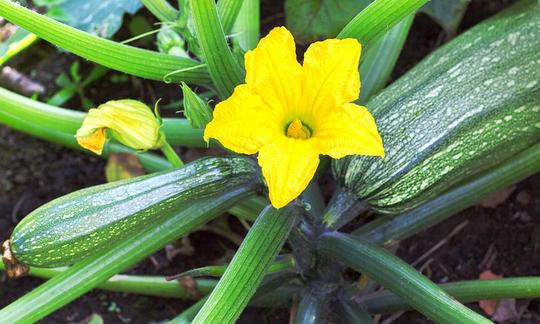

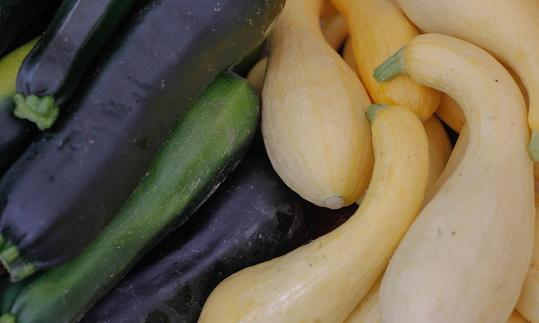

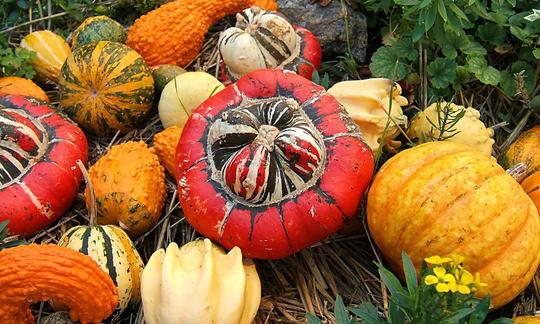

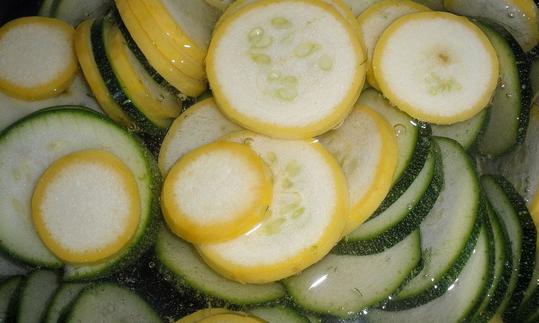

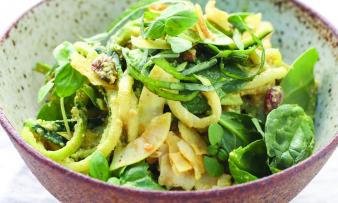





Comments